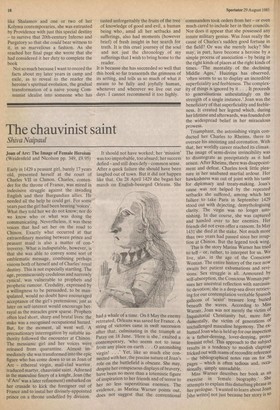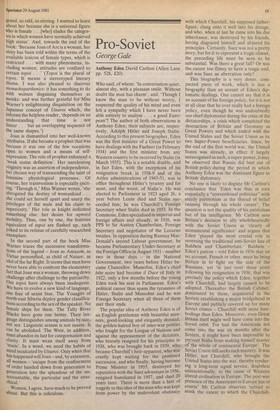The chauvinist saint
Shiva Naipaul
Joan of Arc: The Image of Female Heroism (Weidenfeld and Nicolson pp. 349, £9.95) Early in 1429 a peasant girl, barely 17 years old, presented herself at the court of Charles VII in Chinon. Charles, contender for the throne of France, was mired in indecisive struggle against the invading English and their Burgundian allies. He needed all the help he could get. For some years past the girl had been hearing 'voices'. What they told her we do not know; nor do we know who or what was doing the communicating. Nevertheless, it was these voices that had set her on the road to Chinon. Exactly what occurred at that extraordinary meeting between prince and peasant maid is also a matter of con• troversy. What is indisputable, however, is that she was able to convey some sort of emblematic message, combining perhaps visions both of herself and of Charles' royal destiny. This is not especially startling. The age, promiscuously credulous and narrowly cynical, was vulnerable to prophets and prophetic rumour. Credulity, expressed by a willingness to be persuaded, to be manipulated, would no doubt have encouraged acceptance of the girl's pretensions; just as later on self-interest would encourage betrayal as the miracles grew sparse. Prophets often lead short, sharp and brutal lives: the stake was a recognised occupational hazard. But, for the moment, all went well. A precautionary interrogation by suitable authority followed the encounter at Chinon. The messianic girl and her voices were released from quarantine. Almost immediately she was transformed into the epic figure who has come down to us as Joan of Arc — ethereal virgin, mail-clad warrior, traduced martyr, chauvinist saint. Adorned in the masculine finery of a knight, Joan (the 'd'Arc' was a later refinement) embarked on her crusade to kick the foreigner out of France and to instal her divinely-appointed prince on a throne undefiled by division. It should not have worked; her 'mission' was too improbable, too absurd; her success defied—and still does defy—common sense. After a quick failure she should have been laughed out of town. But it did not happen like that. On 28 April 1429 she began her march on English-besieged Orleans. She had a whale of a time. On 8 May the enemy retreated; Orleans was saved for France. A string of victories came in swift succession after that, culminating in the triumph at Patay on 18 June. 'Here is she,' exulted a contemporary, 'who seems not to issue from any place on earth . . . 0 astonishing virgin! . . Yet, like so much else connected with her, the precise nature of Joan's role on the battlefield is obscure. She may, despite her conspicuous displays of bravery, have been no more than a totemistic figure of inspiration to her friends and of terror to her no less superstitious enemies. The evidence, as Marina Warner points out, does not suggest that the conventional commanders took orders from her — or even much cared to include her in their councils. Nor does it appear that she possessed any innate military genius. Was Joan really the cause of Charles's sudden good fortune in the field? Or was she merely lucky? She may, in part, have become a heroine by a simple process of association — by being in the right kinds of places at the right kinds of times. 'The mentality of the declining Middle Ages,' Huizinga has observed, 'often seems to us to display an incredible superficiality and feebleness. The complexity of things is ignored by it . . . It proceeds to generalisations unhesitatingly on the strength of a single instance.' Joan was the beneficiary of that superficiality and feebleness. It created her legend which, during her lifetime and afterwards, was founded on the widespread belief in her miraculous prowess.
Triumphant, the astonishing virgin conducted her Charles to Rheims, there to oversee his anointing and coronation. With that, her worldly career reached its climax. The image of semi-divine invincibility was to disintegrate as precipitately as it had arisen. After Rheims, there was disappointment and defeat. Charles took little pleasure in her unabated martial ardour. Her hawkishness was out of joint with his taste for diplomacy and treaty-making. Joan's cause was not helped by the repeated setbacks she suffered, among which her failure to take Paris in September 1429 stood out with dejecting, demythologising clarity. The virgin was no longer astonishing. In due course, she was captured and handed over to her enemies. Her friends did not even offer a ransom. In May 1431 she died at the stake. Not much more than two years had passed since her irruption at Chinon. But the legend took wing. This is the story Marina Warner has tried to tell — or, rather, to interpret for us. We live, alas, in the age of the Conscious Woman. The entire history of the race now awaits her patient exhumations and revisions. Sex struggle is all. Armoured by self-absorption, the Conscious Woman pursues her ancestral reflection with narcissistic devotion; she is a deep-sea diver retrieving for our contemplation veritable Spanish galleons of 'sexist' treasure long buried beneath the waves. According to Miss Warner, Joan was not merely the victim of Inquisitorial Christianity but, more fundamentally, the victim of generations of unchallenged masculine hegemony. The exhumed Joan who is held up for our inspection is a father-denying, lover-denying, protofeminist rebel. This approach to the subject results in a tendency to modish claptrap tricked out with reams of recondite reference — the bibliographical notes run on for 56 pages — which is often tedious and, occasionally, simply unreadable. Miss Warner describes her book as an exercise in 'female biography.' She attempts to explain this disturbing phrase in her prologue. 'I wanted to learn about Joan [she writes] not just because her story is so grand, so odd, so stirring. I wanted to learn about her because she is a universal figure Who is female . . .[who] eludes the categories in which women have normally achieved high status'. And, towards the end of the book: 'Because Joan of Arc is a woman, her story has been told within the terms of the available lexicon of female types, which is restricted . . . with many phenomena, including women, attitudes are confined to certain topoi . . (Topoi is the plural of topos. It means a stereotyped literary theme. I was also pleased to discover monachoparthenics: it has something to do With women disguising themselves as monks: and was further grateful for Miss Warner's enlightening disquisition on the Japanese concept of Utsuroi which, she informs the helpless reader, 'depends on an understanding that time is not linear . • . but an overlapping sequence of the same shapes.') Joan is dismantled into her well-known utributes. If she became a prophet that was because it was one of the few vocations Open to women and a means of selfexpression. The role of prophet enhanced a 'weak status definition'. Her unrelenting virginity was an assertion of independence, her chosen way of transcending the taint of feminine physiological processes. Of course, her transvestism is especially exciting. 'Through it,' Miss Warner writes, 'she abrogated the destiny of womankind . . . she could set herself apart and usurp the Privileges of the male and his claim to superiority.' Her role as knight indicated something else: her desire for upward mobility. Thus, one by one, the feminist equivalent of topoi are flashed up, each Yoked to its retinue of carefully researched exemplars.
In the second part of the book Miss Warner traces the successive transformations of the legend — Joan as Amazon, as Virtue personified, as child of Nature, as idol of the far Right. It seems that men have never been able to confront the elementary fact that Joan was a woman, throwing down challenge after challenge to the patriarchy. Our topoi have always been inadequate. We have to evolve a new kind of language, One free of sexist bias. The Youagirs of north-east Siberia deploy gender classifications according to the sex of the speaker. No female ships for them. The Tully River Blacks have gone one better. Their language distinguishes among animals by size, not sex. Linguistic sexism is not innate. It Can be abolished. The West, in addition, must abandon its lust for categorisation and clarity. It must wean itself away from stasis'. In a word, we need the habits of mind inculcated by Utsuroi. Only when that has happened will Joan — and, by extension, all women — 'escape from the confinement of order handed down from generation to generation into the splendour of the unaccountable, the particular and the anarchical.'
Women, I agree, have much to be peeved about. But this is ridiculous.



































 Previous page
Previous page